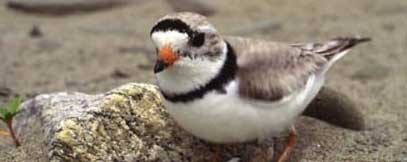
Endangered
- Chooses gravel-sand beaches on which to nest and feed.

Endangered
The piping plover is a small migratory bird. The adult has orange-yellow legs, a black band over its forehead, as well as a black collar around its neck. These features are more distinguished on the male than the female. The piping plover relies on camouflage for protection against predators. Its body is the colour of pale sand which helps it blend in with its habitat. Its black speckled eggs are also well camouflaged, blending in with the beach environment. The female typically lays four eggs, which are then incubated by both parents and hatch in a month.
In New Brunswick, the piping plover chooses a gravel-sand beach on which to nest and feed. Its nest is remarkably simple, consisting of a few scratch marks in small depressions in the sand. This nest is invariably located among pebbles, pieces of driftwood and other debris from the beach, which aid in hiding it. The bird feeds on small crustaceans, marine worms, sea fleas and fly larvae that it finds on mud flats and inter-tidal zones. We can do a lot to help this species by taking some simple precautions, such as avoiding beaches where it nests. In many cases, the areas where we should be most careful are indicated by signs or symbolic fencing. By staying close to the water line and moving through these areas quickly we reduce our potential impact on the bird.
In New Brunswick, the piping plover nests on beaches along the Northumberland Strait. The largest number can be found in the Acadian Peninsula. Historically, it is also known to nest along the Bay of Fundy and Grand Manan Island. It migrates south at the end of summer, and winters along the Atlantic shores between North Carolina and Florida. The piping plover returns to the Atlantic Provinces from the end of March to early May. The eastern subspecies, Charadrius melodus melodus, breeds in Atlantic Canada. The western subspecies, Charadrius melodus circumcinctus, breeds along the Great Lakes and in the Prairies.